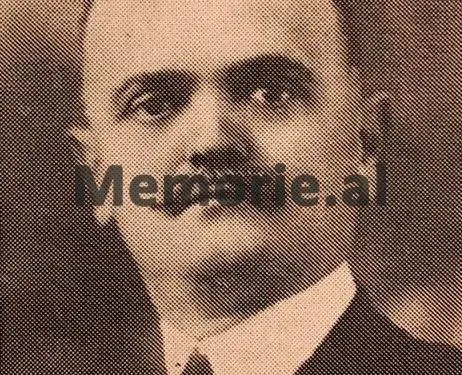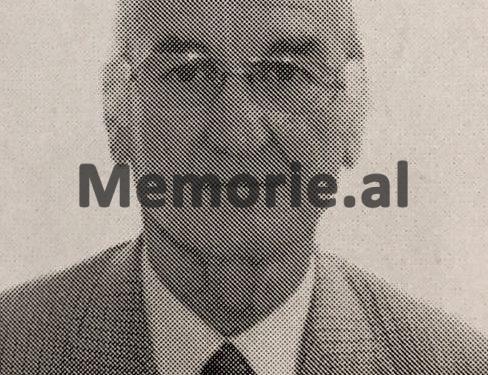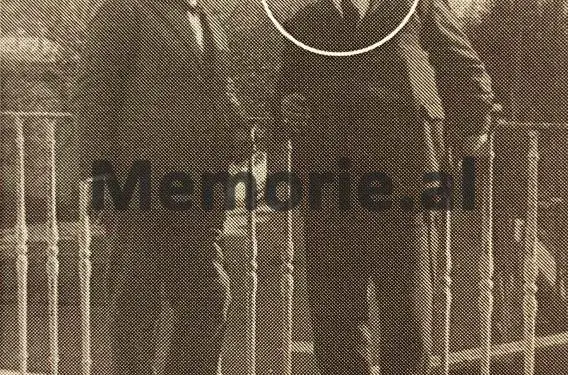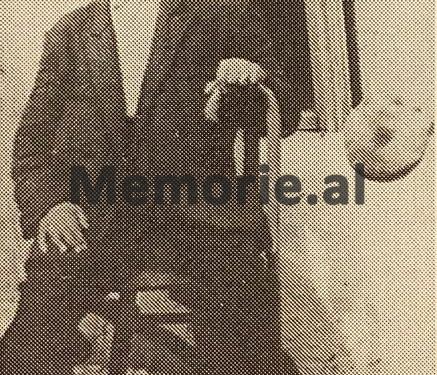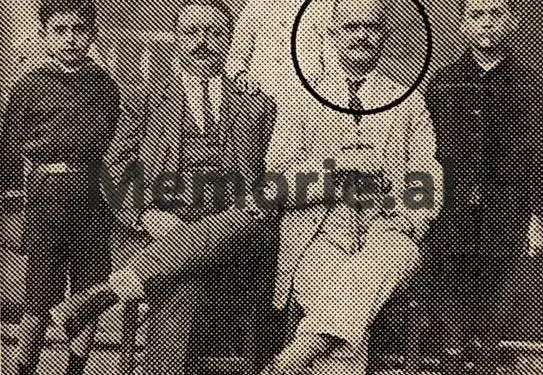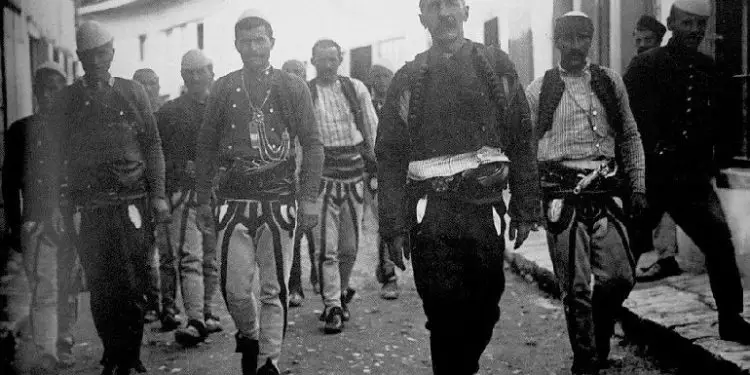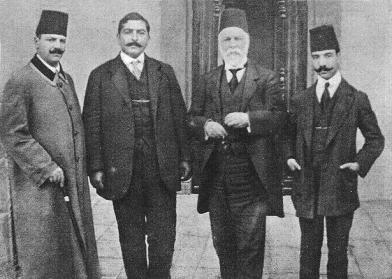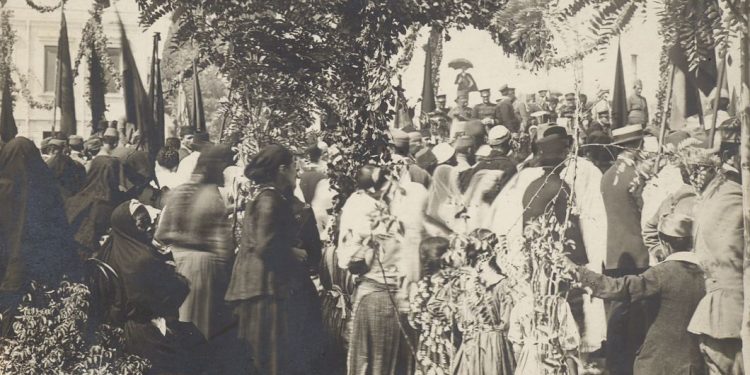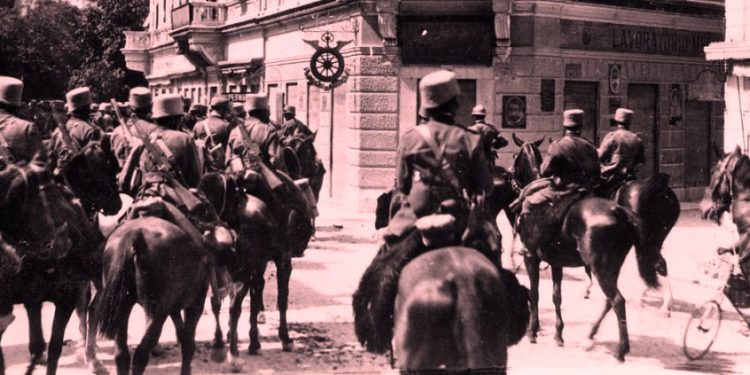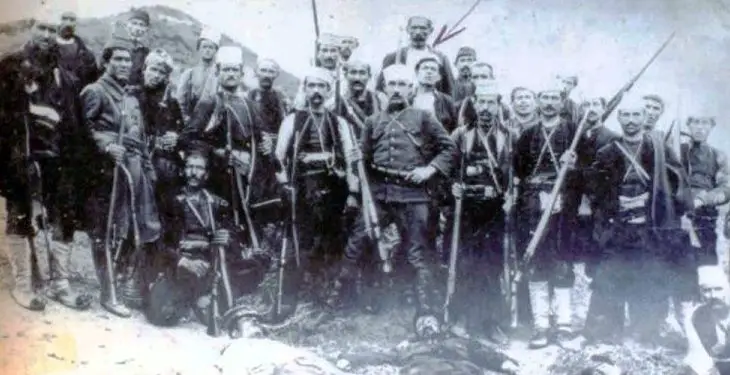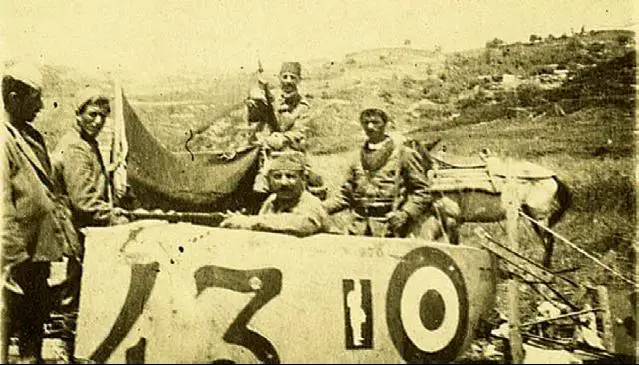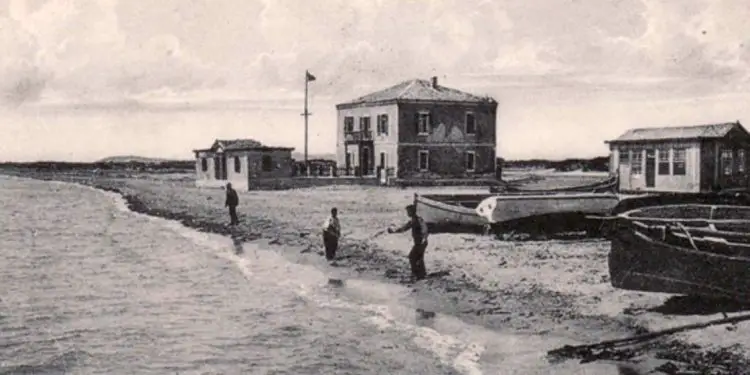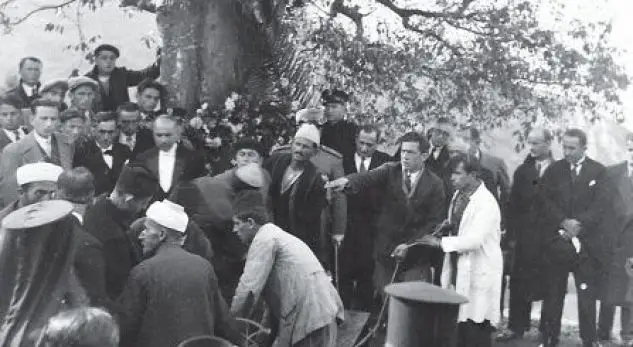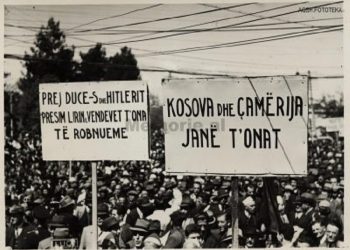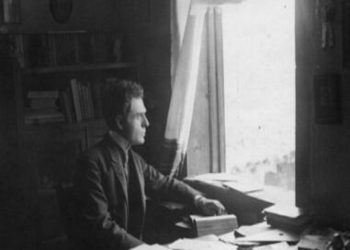Dashnor Kaloçi
Memorie.al publishes the unknown story of Eshref Dano Bocari, originally from the village of Tragjas in Vlora (descendant of the famous Marko Bocari known as the “Hero of the Greek Revolution”), who in November 1912, was charged with The Feast Commission ”, to welcome and accompany Isa Boletini and Ismail Qemali, putting all of them at their disposal and financing large sums of money for the newly formed government headed by the Elder of Vlora. Eshref Dano’s great contribution and commitment in 1914, for the reception of the Cham population who were forcibly expelled from their lands in Greece, settling them in Vlora families and after keeping them for some time at his own expense, he suggested to them so as not to abandon the native lands and ordered and paid the steamer, returning them to their homes in the province of Chameria. The engagement of Eshref Dano in 1919 when the body of Ismail Qemali came to be buried in Vlora, where he together with the Mayor, Ali Asllani, took care of all the ceremonies that took place in honor of the Elder of Vlora. The testimony of Agim Bocari, the son of Eshref Dano, regarding the commitment and funding that his father made to the War of Vlora in 1920, for which the Italians interned his family in Bari, Italy, considering him as “ The background of that war “, Eshrefi’s rejection of King Zog’s proposal to become an MP during the Monarchy period, his refusal to accept the high decoration granted by King Victor Emmanuel III during the occupation of the country, as and his death in complete misery in a rented house in Tirana in 1961, as well as the grand funeral in Vlora attended by over 2000 people and none of the state authorities ?!
“At the end of November 1912, when Isa Boletini came to Vlora to take part in the raising of the Flag, he was received by my father, Eshref Dano Gjonboçari, to whom the ‘Feast Commission’ had entrusted it. the two talked for about an hour head-to-head at the Xhyherjave house, in the Karabash neighborhood, which has been known as a patriotic family. Also during those days when the Independence of Albania was declared, my father received and escorted Isa Boletini several times, along with Ismail Qemali, whom he had one of his closest friends, and when he died poisoned in Italy, Eshrefi took in defense and took care of Ismail Bey’s son, whose life was in danger, and took him out of the borders of Albania. My father Eshref Dano is also known for the great help he gave to the Cham population in 1914 when they were forcibly displaced from their lands in Greece, and in 1920, when he was one of the people who spent and he kept with his money the whole War of Vlora. The Italians considered the large financial aid he provided “the backdrop of that war” and although he was interned with his family in Bishelje (Bari), Italy, they were forced to respect him as an aristocratic family. This is how he remembered, among others, Agim Bocari, his father, Eshref Dano Gjonboçari, and the story of his very famous family, which derives from the trunk of the famous Marko Bocari of Suli, the hero of the “Greek Revolution”, who has the tomb in the Pantheon of Greece and is a sucker from the door of Gjon Boçari from Tragjasi of Vlora, who six centuries ago had built the famous castle, the ruins of which are found and today there in the old village of Tragjas. But who is Eshref Dano Gjonboçari and what is the origin of his family? What are Eshref Dano’s blood ties with the famous Sulu Marko Bocari who helped in the victory of the “Greek Revolution” and with Gjon Bocari who built Tragjas Castle in the 15th century? Why in November 1912, when Ismail Qemali was preparing to raise the flag in Vlora, the ‘Feast Commission’ charged Eshref Dano Gjonboçari to wait for Isa Boletini and why he defended and took care of Ismail Qemali’s son, escort him out of Albania immediately after his father’s death? What is Ashraf’s contribution in 1914 to the reception of the Chams who were forcibly expelled from their lands in Greece? What was the economic situation of Eshref Dano Bocari and what properties did he have at that time that financed the War of Vlora, making the Italians consider it as “the background of that war” and introducing it in Bari, Italy with the whole family? What is his activity during the years of the Zog Monarchy and how did Eshrefi manage to become one of the greatest benefactors so much that he was known as the “Fountain of Fukara” ?! What were his connections with the well-known politicians of those years and with the Italian senator De La Rocca, and why did he not accept the “Cavaliere” decoration from the Royal Family of Savoy, Italy? What was the attitude of him and his family during the period of fascist occupation of Albania and why he who was considered one of the richest people with 220 hectares of land, and one of the greatest benefactors, was looked down upon and had problems by the communist regime of Enver Hoxha? How did he live during the communist regime and how did he die in misery, without having the opportunity to have his own house in Tirana, where he lived as a tenant until 1961 ?! Regarding these and many other facts from Eshref Dano Boçari and his family, we will get to know him in this article through the testimonies of Agim Boçari, his son.
Who is Eshref Dano Bocari?
The earliest origin of the Bocari family is from Thessaloniki, from where after the 11th century, they moved to the province of Dibra and Kruja, and after the death of Skanderbeg, they settled in Tragjas of Vlora, where the ruins of today are still located. The castle of John Bocar, the prince who built it. Also in the emblem of Bocari, which has a lion that resembles it in the coat of arms of the city of Tirana, is engraved on the walls of the University of Padua in Italy, wherein 1662, Nikola Bocari studied. From the trunk of this family is Eshref Dano Boçari, who was born in 1886, in the ‘New Neighborhood’ of the city of Vlora, where his father, Ismaili, had come from 1870, after moving from Tragjasi… Ashraf was educated in one of the Turkish schools (Mejtep) that were in that province at that time, and he did not go any further, because he was taught Albanian, which was secretly taught at that time. At that time, Eshrefi, together with some of his friends, was busy distributing Albanian books, which he received from some secret societies of that time. At that time, the distribution of books in the Albanian language that came secretly from Istanbul was slow, it posed a great danger, and for that Ashraf had the protection of Sali Murat Vranishti and his gang, with which he cooperated for some time.
After the death of his father, Ismail, and his mother, who was from the Suparak tribe of Elbasan, in 1907, when Eshrefi was no more than 20 years old, he took over the burden of the whole family and took over the entire administration. of the family estate, which at that time had over 220 hectares of land, of which 130 hectares were on the coast, with several thousand olive roots. Ashraf married in 1905, and from that marriage, eight sons and a daughter were born to him. His sons were named: Njazi, Ismail, Skënder, Mithat, Muhedin, Gjon, Agim, and Agron, while his daughter Hava
Waiting for Isa Boletini in Vlora
Eshref Dano Boçari was known as one of the most influential people and he had a great friendship with Ismail Qemali and his family. In this regard, his son, Agimi, testified: “At the end of November 1912, when the Declaration of Independence was being prepared, the ‘Feast Commission’ set up to receive the delegates appointed Father Ashraf to receive Isa Boletini. Isa’s father met him at the Xhyher family in the Karabash neighborhood, and they both talked face to face for several hours. In those days, in addition to Isa Boletini, 26-year-old Eshrefi received and escorted Ismail Qemali, who was made available to him and the government he headed, helping him with money. In late January 1919, when word spread throughout Italy that the poisoned Ismail Qemali had died in Italy, Eshrefi and the Vlora chief of staff gathered to discuss what to do. Also in February 1919, when the body of Ismail Qemali was buried in Italy to be buried in Albania, Eshrefi was one of those assigned to organize the funeral ceremony. When Ismail Bey’s body arrived in Vlora, his coffin was covered with the Italian flag, and Ali Asllani, along with Eshref and several other patriots, removed it and covered it with the national flag. On that day, Ali Asllani wrote a poem where, among other things, it is said: “Vlora did as she wished / She wore it with her banner / She dressed the old man with the banner, / With the bajrak the blood color”. During the funeral ceremony of Ismail Bey in Kanina, Eshrefi also spoke, where, among other things, he said: “My son, my son, / Long live and die for Albania, / As he lived and died.” After the burial of Ismail Qemali, the parish of Vlora charged Ashraf to ensure the escort of his son out of Albania, as his life here was in danger. The father was personally involved in that problem and for his security, he charged Ramadan Ali, Xhevit Ali, and Feti Haxhiu, who accompanied him to the border, from where he fled to Italy, joining the rest of the family “, Agim Boçari testified. , for his father Eshref Dano, who in 1912 received Isa Boletini and in 1919 was taken to the funeral ceremony of Ismail Qemali.
The Cham refugee in 1914
Eshref Dano Bocari is also known as one of the great philanthropists, for the fact that in 1914, he was received with the expectation and settlement of the Chams, who had been forcibly displaced from their lands in Greece. For this, Agimi testified: “In 1914, when the Greek government forcibly expelled thousands of Albanians from Chameria, who came to Vlora, Eshrefi was personally taken by their reception and he spent large sums of money to settle them. in Vlore. At that time, the father went to every house in Vlora, which had sheltered Chams, and took care of them for any problems they had. From the great contribution he made at that time to the settlement of the Chams, his name became very well known to almost all the Chams who came to the district of Vlora. At that time, the father also did a great deal of propaganda to the Chams so that they would not leave their ancestral lands in Greece, and after he managed to persuade a large part of them, he spent large sums of money on gold. brought the steamer, which he made available to them, and returned them to Chameria. Since then, the father has formed a close friendship with many Cham families, such as those of Alush Takes, Hajro Plaku (who grew up in our family) Musa Demi, Rasim Babametos, etc., and he always told us to maintain the friendship with those families “, Agimi recalled, regarding his father, Eshrefi, who helped the Cham population, whom he helped in 1940 when they came back to Vlora and he kept them at his own expense, as the Municipality did not allocate funds.
Funds the War of Vlora
Eshref Dano Boçari was one of those patriots who spent large sums of gold to keep the Albanian volunteers who went to Vlora in June 1920, to fight against the Italians. Regarding this, Agimi testified: “In the Vlora War, Father Eshrefi made a great contribution by helping with money to keep the volunteers who went there from all over Albania. At the time, Eshrefi was interested in setting up the Kota-Drashovica field hospital, which was set up to treat the wounded of the war and was run by Sezai Como Libohova, whose father had a family friend. Regarding the financial aid given by the father, the former nurse of that hospital, Hasan Murat Goxho, wrote in his memoirs: ‘Dr. Sezaiu asked Eshref Danos to help him not only in money but also to be interested and to find medicines and other means necessary for the hospital. Ashraf did not hesitate and he helped her wholeheartedly, fulfilling all the requirements. ‘ Ashraf’s assistance not only ended with what he gave for the Vlora War, but he continued even afterward, giving large sums of money to the General Hospital of Vlora, which had 50 beds, as well as to the Psychiatric Hospital, with 40 beds. These contributions are recorded in the registers of the Municipality of Vlora at that time, as well as in those of the Ministry of Health. For the cash financing that Eshrefi gave in the Vlora War, the Italians interned the family member (with my wife My never and sons Niazi and Ismet) in Bisceglie (Bari), Italy. In addition to those funding, Eshrefi was constantly interested in the poor families of Vlora, helping them with money, and especially taking care of their education. He helped so many families at that time that in Vlora he was otherwise known by the epithet “Fountain”, or “Father of Fukara”. After the Vlora War, the father participated as a delegate in the Congress of Labëria, which was held in the village of Kuç, on November 28, 1924, which was reflected by many newspapers of that time such as “Dajti”, “Politika”. “Nation”, “Democracy”, etc. At that time, Eshrefi had close friendships with many of the ministers, deputies, and politicians, such as Sulejman Delvina (Prime Minister) Nuredin Bey Vlora, (Mayor of Vlora) Rasim Babameto (Prefect of Gjirokastra) Qazim Koculi, Ali Këlcyra, Baba Ahmeti, ( Bektashi World Grandfather) Tol Arapin, Dom Nikoll Kaçorin, etc., and in 1924, when the Conservative Party won the local elections in Vlora, my father told me that one of the most famous beys of Vlora came home. and after sitting on his knees in front of his father, he said: “Ashraf, you saved us”, testified Agim Bocari, regarding the contribution of his father, Ashraf, who was one of those patriots who spent large sums of gold for the War of Vlora and the financing of the electoral campaign of the Conservative Party (which the beys of Vlora recognized as its merit) against the People’s Party, which saw the beys and the rich families of that time as enemies.
Rejects Italian decoration
Eshref Dano Bocari refused to get involved in politics, but he devoted himself only to his work and property, as well as to charity. In this regard, his son Agimi testified: “At that time, in addition to 220 hectares of land, of which over 120 hectares were on the coast of Jonufri, our family had thousands of olive roots and 1 mill of flour grinding (it was left free for the people), which Ashraf had inherited from his father, Ismaili. In addition to these inherited properties, Father Eshrefi in 1927 set up a Flour Factory, which cost 12,000 gold napoleons and was very modern at the time, a mill in Mifol, one in Fier and one in Ersekë, 15 baxho for cheese, which he exported to Italy, as well as four pairs of houses in Vlora, which were located near the old hospital of Zog’s time. At the time, the father was friends with Italian senator De la Rocca, who, in good faith, without any documents, made a large sum of money available to him, which his father returned on time. After that, the friendship with the Italian senator became even closer and he often invited Ashraf to Italy, where he introduced him to the Martinez family from Brindisi. In addition to Italy, at that time his father had friendships with many families and personalities of politics and economics from different European countries, such as England, France, Greece, etc., who whenever they met with him, asked him to sent children to study in those states under their care. They became the reason for the two brothers, Niazi and Ismail, to study and graduate in Corfu and Bologna. In 1937, King Zog sent home the Minister of the Court, Sotir Martin, to ask him to become a Member of Parliament, but the father refused and said to Sotir: ‘Say thank you to the King, but it is too late now. I take that task ‘. After the invasion of Albania in 1939, as part of the conciliatory policy that the Italians began to pursue towards Albania, the King of Italy awarded him two decorations “Knight of the Savoja family”, which was the title of nobility, to give them to two personalities. known in Albania. One of the descendants of the Bushatllin family was appointed for them and one for Ashraf. Eshrefi refused to take that high title, saying: “To become a cousin of the King of Italy before the invasion of Albania I would call it an honor and I would gladly accept it, but after the invasion of Albania, it is no longer an honor for me.” testified Agim Boçari, regarding his father Eshrefi, who did not accept Zog’s offer for deputy and the decoration that the family of King Victor Emanuel asked him to give.
Magnificent burial in Vlora
During the years of fascist occupation of Albania, Ashraf’s family in Vlora became one of the main bases of the War, making available to the elderly people for weapons, its name, and wealth. After the end of the war, our family was not well received by the communist regime that came into force, because brother Ismaili, after going abroad to study, did not return to Albania, but went to Italy. After Ismail’s departure, our family had a lot of problems with not giving their father’s patriotic pension. The brothers also moved from where they worked. Until 1951, when private activity was allowed, the father engaged in trade, bringing citrus to Tirana. He then locked himself in the house we rented, rarely leaving, but always under the care of family and friends who came to visit. Eshrefi died in 1961 in Qishbardhë, Vlora, while on his way to his hometown. At his funeral, although none of the state authorities attended, the people of Vlora honored him with a spontaneous massive turnout. In that morning, all the shops in Vlora were closed and people rushed to attend his funeral, where about 2000 people gathered “, concludes his story Agimi, for his father Eshref Dano, the famous descendant Marko Boçari and one from the most famous men of Vlora, who kept with his expenses the Chams who also gave in 1914, financed the War of Vlora of 1920 and all the poor families, who when he died, sang to him: “O Eshref heart of generosity / Heritage from the first / Patriot, patriot / Race and tribe from Gjonboçari / Even the stones are crying today / O father, soul for the poor ”.
The Bocari family, the descendants of Marko Bocari, “Hero of the Greek Revolution”
According to many oral testimonies and historical data, the Boçari family originates from the village of Tragjas in the district of Vlora, where even today are the ruins of the famous Castle (in the old village of Tragjas) known as Gjon Boçari Castle, which is one of the first of this family. From the archeological data that date this castle built there from the 15th century, it is thought that the first of this family, Gjon Boçari, was located there at the beginning of that century. It is also thought that: when the last descendants of the Arianites left Albania for Venice, the Castle of Gjon Boçari existed in Tragjas. Regarding the early origin of the Bocari family, there are some hypotheses that it originates from Thessaloniki, from where they later moved to the province of Dibra and from there, after staying for a short time in Kruja, they came down. in the south of the country, settling in the village of Tragjas in Vlora. According to the oral testimonies of both the descendants of this family and the scholars, it is thought that the Bocari family was divided into three parts, settling in Greece, Italy, and the rest remaining in Albania. The separation of this family came after the death of Skanderbeg, when many of the Albanian princes left Albania, settling in Southern Italy, where their descendants (Arbëresh) live today. From this division of the Bocari family, both those who settled in Greece and those who settled in Southern Italy, no descendants of it remain. There is evidence that some descendants of the family who emigrated to Greece have not been assimilated, although they have changed their surname to the Greek suffix, usually with the surname Bocaris. From the beginning of the 17th century, this family is known by two other surnames, named Gjon and Dano Boçari. Since the change of surname, many of the descendants of her trunk have preserved it to this day, where her sucklings, along with the surnames Dano, place the first, Gjon Boçari, in order to be known that belong to that family. This is confirmed by the fact that some of the descendants of this family still live in the village of Tragjas and another part in Vlora and Tirana. One of the well-known names of the Boçari family is that of Gjergj Boçari, who lived in the village of Sul after moving from Tragjasi. From the oral and doctrinal data, it is said that Gjergji was married three times and from those marriages, he had 18 children and the most mentioned was Kiçoja, who is the father of the famous Marko Bocari, not only in the trunk of this family. , but also in the History of Albania and the Balkans. Marko Bocari was born in 1788 and is known as the “Hero of the Greek Revolution” and his grave is today in the Pantheon of Greece, along with the most prominent personalities of that nation. Dozens of books by foreign authors have been written about Marko Bocari, such as Byron, Viktor Hugo, Pukvilli, Blejker (English), August Fabre, and Bryne de Prel (French), Vakallopullos (Greek) and many others. Regarding the portrait of Marko Bocari, the famous scholar Pukvilli, who has been in the palaces of Ali Pash Tepelena for some time, wrote, among other things: “To honor Lord Byron, the Greeks told him that they would give him the sword of Marko. Bocari during a mass in the church, but Byron was told that Marko’s sword, he would only take over his grave. The Greeks did as Byron was told, and when they gave him the sword over his grave, he said, “From this voice that comes out of this grave, comes the Freedom of Greece itself.” Also in another description that Pukvilli gave to Marko Bocari, he said: “Marko Bocari had something extraordinary, so much so that he was taken as a descendant of the Pelasgians, sons of Fedhon who civilized Epirus.” Prof. Marko Bocari’s figure is also used. Dr. Koli Xoxi, (one of the most famous historians in Albania) who, among other things, wrote: “For Marko Bocari, the Greek revolutionary government led by the hydration Arbëresh, Gjergj Kundurioti, declared mourning and the national ceremony. In addition, he sent a letter to his daughter, Ada, saying, among other things: “In your mourning, you are friends with Greece.” One of the other well-known names of the Boçari family is Çaço Danos, otherwise known as “Çaço Këmisha”, who is the grandson of Anastas Danos, Gjergji’s brother. Çaço Dano (Shirt) is known as one of the leaders of the fighters of the province of Dukati and Bregu who fought against the Turkish army, led by Ali Pash Tepelena, in his intentions to take possession of that province. One of the other scholars who has dealt with the history of the Bocari family is Arif Thanasi, who in his book “Tana e Labëria”, which he has not been able to publish, among other things, writes: “With the surname Boçari, there is no other family in Albania but Sulit and Tragjas, who come from the same family, the Bocars of Mirdita, who moved from that province at the time of the Turkish invasion of Albania, going one part to Sul of Ioannina and the other which remained in Tragjas. Based on some legends, some of the first inhabitants of Tragjas, before Gjon Boçari and Gjon Mistri, whose genealogy is not known today, were Mënga Leka, Dedë Çobani, Kol Toç, etc. The oldest families that have established the village of Tragjas and have left descendants to this day, have been those of Gjon Boçari and Gjon Mistrit ”. One of the descendants of the trunk of this family, which belongs to the part that was not displaced from Albania, is the family of Ismail Bocari, who is the grandson of Chacho. Ismail Gjon Boçari moved from his village Tragjas and settled in Vlora there around 1870, where he married a girl from the well-known door of the Elbasan Supercars. From this marriage in 1886, they had a son named Eshref Dano Boçari and a daughter named Qafshije. Ismail Dano (Gjonboçari) is said to have been poisoned by a Greek doctor around 1906, as he was known as a staunch opponent of their intentions. Regarding the heritage of Eshref Dano (Gjon Boçari) as a descendant of the trunk of Gjonboçarë, it is said in one of the folk songs where, among other things, it is said: “This Eshrefi of Boçari / blood from the blood of the first”. There is also another song which was sung by the people of Vlora until recently, where among other things it is said: “Uncle Eshref, generous heart / Inheritance from the first / Rac and Gjonboçari tribe”/Memorie.al




